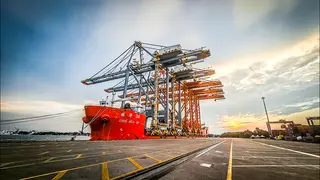Tata Steel, which recently made use of the inland waterways transport (IWT) to bring in heavy machinery for its Kalinganagar plant expansion project, is stepping up movement of products, particularly to the northeast through this transport mode. Plans are afoot to explore the possibility of transporting products to Bangladesh using the system.
Tata Steel’s consignment sailed in a chartered vessel from Shanghai to Odisha’s Paradip port; loaded on a barge that travelled up Luna River and was finally unloaded at Marsaghai, in Kendrapara district. Thereafter, the consignment was transported via road to the project site.
The company’s engineering and project division used multimodal logistics, including IWT, to ship nearly 1,000 cubic metre of four super over dimensional assembled cargo, with each weighing around 100 tonnes and a diameter of 8 metre.
Peeyush Gupta, Vice President, Supply Chain, Tata Steel, said, transportation of the oversized cargo to the Kalinganagar plant happened more by chance as it would have been difficult to put it on a trailer and bring it out of the port. But, it has turned into an opportunity and the company would be keen to explore the possibility of using IWT for outbound movement of products, particularly to the northeast. The company has also signed an MoU with Inland Waterways Authority of India (IWAI).
"What happened due to serendipity is turning out as a good opportunity as we can now move many more things very close to the river, and we are working with that," Gupta told BusinessLine.
The company had done a trial shipment to Bangladesh early part of last year. It had also shipped to Tripura four years back and to Pandu in Guwahati recently. “This has been our plan and we have been doing trials and pilots, and this year we want to take definite steps. In the northeast, we want to try two to three places which are currently being serviced by rail, by using inland waterways,” he said.
Good potential
A study by RITES says that 1 litre of fuel will move 24 tonne through 1 km on road; 95 km on rail and 215 km on IWT.
“We were looking for a way to do it (transport) in a sharper and better way and that is why IWT comes in. The cargo can be protected since each barge is covered and there is no issue thereafter,” he pointed out.
While the IWAI is keen to promote traffic, the onus is on them to take care of cargo when it is unloaded and ensure that the channel is made available. The biggest stumbling block in inland waterways is the handling of the product at the destination port, said Gupta. These are still early days and it may be difficult to quantify the cost advantage in IWT, he added.










Comments
Comments have to be in English, and in full sentences. They cannot be abusive or personal. Please abide by our community guidelines for posting your comments.
We have migrated to a new commenting platform. If you are already a registered user of TheHindu Businessline and logged in, you may continue to engage with our articles. If you do not have an account please register and login to post comments. Users can access their older comments by logging into their accounts on Vuukle.